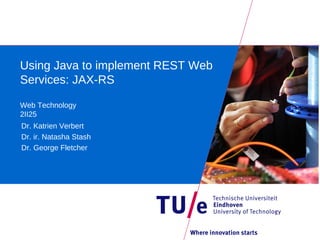
Using Java to implement RESTful Web Services: JAX-RS
- 1. Using Java to implement REST Web Services: JAX-RS Web Technology 2II25 Dr. Katrien Verbert Dr. ir. Natasha Stash Dr. George Fletcher
- 2. Restful Web Services Frameworks and APIs • JAX-RS - The Java API for RESTful Web Services • uses annotations to make plain old Java objects (POJOs) and resources available through HTTP • Sun Reference Project: Jersey • Other Vendors: CXF (Apache), RESTEasy(JBoss) and Restlet • JAX-RS tutorial: http://docs.oracle.com/javaee/6/tutorial/doc/gilik.html
- 3. JAX-RS HTTP • Templated mapping and subresources @Path • MIME handling @Provides, @Consumes • HTTP methods @GET, @POST, @UPDATE, @DELETE, @HEAD, @OPTIONS, @HttpMethod • Caching evaluatePreconditions
- 4. Example package com.sun.jersey.samples.helloworld.resources; import javax.ws.rs.GET; import javax.ws.rs.Produces; import javax.ws.rs.Path; // The Java class will be hosted at the URI path "/helloworld" @Path("/helloworld") public class HelloWorldResource { // The Java method will process HTTP GET requests @GET // The Java method will produce content identified by the MIME Media // type "text/plain" @Produces("text/plain") public String getClichedMessage() { // Return some cliched textual content return "Hello World"; } }
- 5. @Path Annotation and URI Path Templates @Path annotation • identifies the URI path template to which the resource responds • is specified at the class or method level of a resource URI path templates are URIs with variables embedded within the URI syntax • these variables are substituted at runtime • variables are denoted by braces ({ and }) @Path("/users/{username}") • example request http://example.com/users/Galileo
- 6. @PathParam annotation To obtain the value of the user name, the @PathParam annotation may be used on the method parameter of a request method @Path("/users/{username}") public class UserResource { @GET @Produces("text/xml") public String getUser(@PathParam("username") String userName) { ... } }
- 7. Examples of URI Path Templates URI Path Template URI After Substitution http://example.com/{name1}/{name2}/ http://example.com/james/gatz/ http://example.com/{question}/ http://example.com/why/why/why/ {question}/{question}/ http://example.com/maps/{location} http://example.com/maps/Main%20Street
- 8. @Produces Annotation @Produces annotation is used to specify the MIME media types or representations a resource can produce and send back to the client • applied at the class level: default for all methods • applied at the method level overrides any @Produces annotations applied at the class level
- 9. @produces annotation @Path("/myResource") @Produces("text/plain") public class SomeResource { @GET public String doGetAsPlainText() { ... } @GET @Produces("text/html") public String doGetAsHtml() { ... } }
- 10. @Consumes Annotation @Consumes annotation is used to specify which MIME media types of representations a resource can accept @POST @Consumes("text/plain") public void postClichedMessage(String message) { // Store the message }
- 11. Develop Restful service in Netbeans 03/28/11
- 12. Develop Restful service in Netbeans 03/28/11
- 13. Develop Restful service in Netbeans 03/28/11
- 14. Develop Restful service in Netbeans package orders; import javax.ws.rs.*; @Path("order") public class OrderResource { public OrderResource() { } @GET @Produces("application/xml") public Order getLastOrder() { return Orders.getLastOrder(); } @PUT @Consumes("application/xml") public void putOrder(Order order) { Orders.setLastOrder(order); } }
- 15. Develop Restful service in Netbeans package orders; public class Orders { private static Order lastOrder=new Order(); public static Order getLastOrder() { return lastOrder; } public static void setLastOrder(Order lastOrder) { Orders.lastOrder = lastOrder; } }
- 16. Deploy Restful service in Netbeans 03/28/11
- 17. Test Restful service in Netbeans 03/28/11
- 18. 03/28/11
- 19. Testing Restful services Netbeans test client does not work well with XML parameters Better alternative: RESTClient, a debugger for RESTful web services https://addons.mozilla.org/nl/firefox/addon/restclient/ 03/28/11
- 20. RESTClient 03/28/11
- 21. Testing Restful services If you pass XML strings as parameters, you need to specify this in the header 03/28/11
- 22. Add header parameters 03/28/11
- 23. Add header parameters 03/28/11
- 24. Placing an order 03/28/11
Notas del editor
- helloworld
- The @Consumes annotation is used to specify which MIME media types of representations a resource can accept, or consume, from the client. If @Consumes is applied at the class level, all the response methods accept the specified MIME types by default. If applied at the method level, @Consumes overrides any @Consumes annotations applied at the class level.If a resource is unable to consume the MIME type of a client request, the JAX-RS runtime sends back an HTTP 415 ( “ Unsupported Media Type ” ) error.The value of @Consumes is an array of String of acceptable MIME types. For example:@Consumes({"text/plain,text/html"})The following example shows how to apply @Consumes at both the class and method levels:@Path("/myResource")@Consumes("multipart/related")public class SomeResource { @POST public String doPost(MimeMultipart mimeMultipartData) { ... } @POST @Consumes("application/x-www-form-urlencoded") public String doPost2(FormURLEncodedProperties formData) { ... }}The doPost method defaults to the MIME media type of the @Consumes annotation at the class level. The doPost2 method overrides the class level @Consumes annotation to specify that it can accept URL-encoded form data.If no resource methods can respond to the requested MIME type, an HTTP 415 ( “ Unsupported Media Type ” ) error is returned to the client.The HelloWorld example discussed previously in this section can be modified to set the message by using @Consumes, as shown in the following code example:@POST@Consumes("text/plain")public void postClichedMessage(String message) { // Store the message}In this example, the Java method will consume representations identified by the MIME media type text/plain. Note that the resource method returns void. This means that no representation is returned and that a response with a status code of HTTP 204 ( “ No Content ” ) will be returned.
